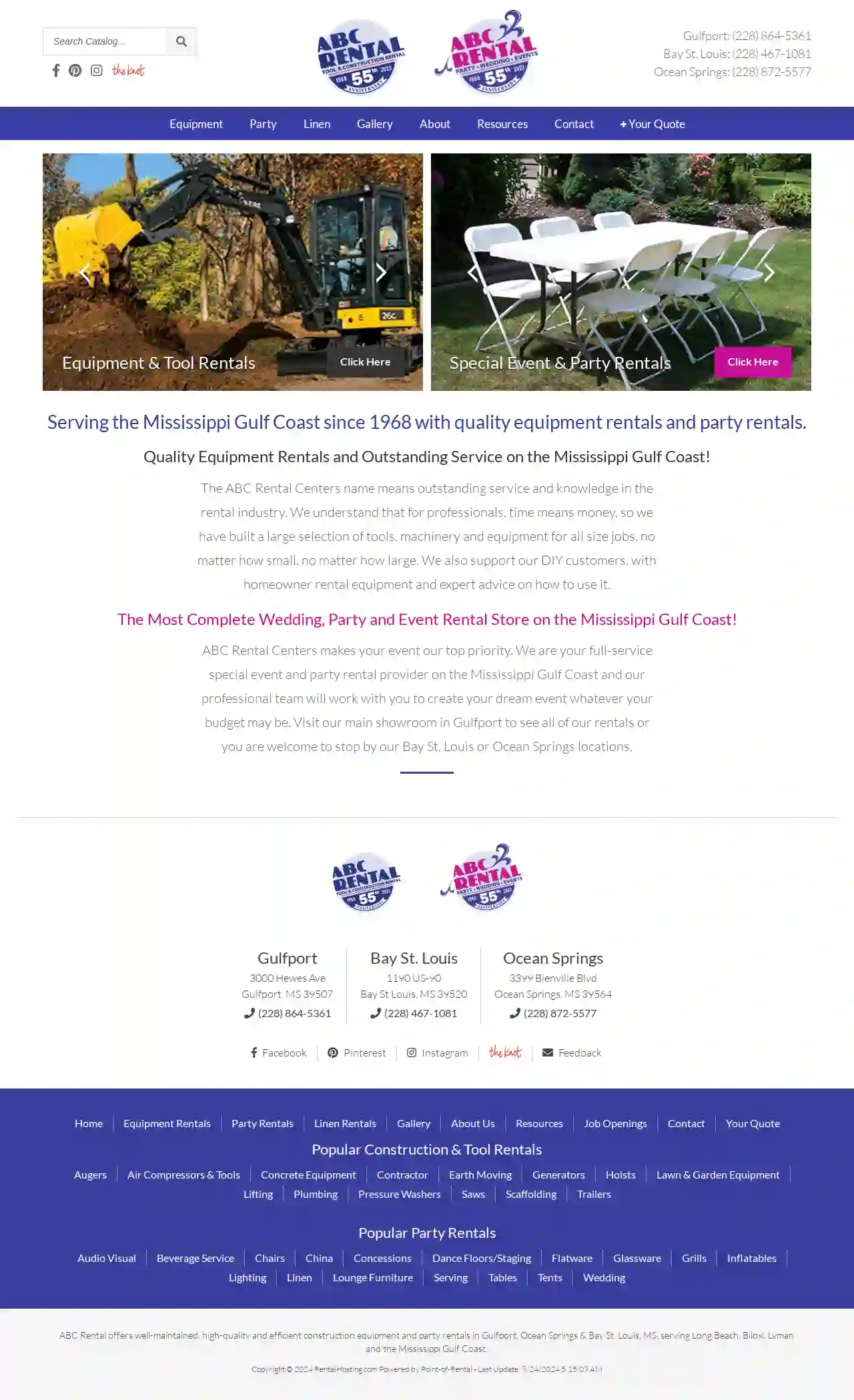Scaffolding Rental Columbia
Find Scaffolding Rental Services in Columbia
Receive up to 3 Temporary Scaffolding quotes for your project today! Compare profiles, reviews, accreditations, portfolio, etc... and choose the best service.
Service Needed
City or Town

ABC Rental Center
4.4151 reviews3000 Hewes Ave, Gulfport, 39507, USABC Rental offers well-maintained, high-quality and efficient construction equipment and party rentals in Gulfport, Ocean Springs & Bay St. Louis, MS, serving Long Beach, Biloxi, Lyman and the Mississippi Gulf Coast. With a wide range of equipment and party rentals, ABC Rental is dedicated to providing outstanding service and knowledge in the rental industry.
- Services
- Why Us?
- Gallery
Get Quote- Ma
Magnolia Masonry of South Mississippi LLC
4.914 reviewsGulfport, US- Services
- Why Us?
Get Quote - Lo
Lowe's Home Improvement
4.1Gulfport, US- Services
- Why Us?
Get Quote - Cr
Crom Equipment Rentals Inc
Gulfport, US- Services
- Why Us?
Get Quote - Th
The Home Depot
4.2Gulfport, US- Services
- Why Us?
Get Quote
Over 2,353+ Scaffolding Businesses onboarded
Our scaffolding pros operate in Columbia and beyond!
ScaffoldingHQ has curated and vetted the Best Scaffolding Companies arround Columbia. Find a reliable pro today.
Frequently Asked Questions About Scaffolding Rental
Get answers to common questions about scaffolding rentals and finding the right scaffolding rental company in the USA.
- Base Plates and Adjusters: Use adjustable base plates to level the scaffolding legs on uneven surfaces.
- Ground Preparation: Level the ground as much as possible before erection.
- Bracing and Support: Additional bracing and support may be necessary to compensate for uneven ground conditions.
- Professional Assessment: A qualified scaffolding erector should assess the ground and determine the appropriate measures for safe erection.
- Stop Using It Immediately: Do not attempt to use damaged scaffolding. It could be unsafe.
- Contact the Rental Company: Notify the scaffolding rental company about the damage as soon as possible.
- Document the Damage: Take photos or videos of the damage for documentation. The rental agreement should outline the procedures for handling damaged equipment. You may be responsible for repair or replacement costs, depending on the circumstances and the terms of the agreement.
- Residential: Roofing repairs and replacements, siding installations, painting projects, window replacements, gutter cleaning and repairs, chimney repairs, solar panel installations.
- Commercial: Building construction and renovations, facade repairs and cleaning, window cleaning, painting, sign installation, and maintenance of high-rise structures.
- Industrial: Plant maintenance, access to elevated equipment, tank inspections and repairs, bridge repairs, and other industrial construction projects.
- Events: Temporary stages, grandstands, lighting and sound rigging, and platforms for concerts, festivals, and sporting events.
Can I use scaffolding on uneven ground?
Scaffolding can be erected on uneven ground, but it requires careful planning and adjustments to ensure stability:
Can I modify or alter the scaffolding after it's erected?
Do NOT modify or alter the scaffolding in any way without consulting the scaffolding rental company or a qualified scaffolding engineer. Any unauthorized modifications can compromise the structural integrity and safety of the scaffolding. If you need to make changes to the scaffolding configuration, contact the rental company. They can advise on safe adjustments or make the modifications themselves.
What happens if the scaffolding is damaged during my rental period?
If the scaffolding is damaged during your rental period:
What are some common uses for scaffolding rentals?
Scaffolding rentals are widely used in various construction and maintenance projects, including:
Can I use scaffolding on uneven ground?
Scaffolding can be erected on uneven ground, but it requires careful planning and adjustments to ensure stability:
- Base Plates and Adjusters: Use adjustable base plates to level the scaffolding legs on uneven surfaces.
- Ground Preparation: Level the ground as much as possible before erection.
- Bracing and Support: Additional bracing and support may be necessary to compensate for uneven ground conditions.
- Professional Assessment: A qualified scaffolding erector should assess the ground and determine the appropriate measures for safe erection.
Can I modify or alter the scaffolding after it's erected?
Do NOT modify or alter the scaffolding in any way without consulting the scaffolding rental company or a qualified scaffolding engineer. Any unauthorized modifications can compromise the structural integrity and safety of the scaffolding. If you need to make changes to the scaffolding configuration, contact the rental company. They can advise on safe adjustments or make the modifications themselves.
What happens if the scaffolding is damaged during my rental period?
If the scaffolding is damaged during your rental period:
- Stop Using It Immediately: Do not attempt to use damaged scaffolding. It could be unsafe.
- Contact the Rental Company: Notify the scaffolding rental company about the damage as soon as possible.
- Document the Damage: Take photos or videos of the damage for documentation. The rental agreement should outline the procedures for handling damaged equipment. You may be responsible for repair or replacement costs, depending on the circumstances and the terms of the agreement.
What are some common uses for scaffolding rentals?
Scaffolding rentals are widely used in various construction and maintenance projects, including:
- Residential: Roofing repairs and replacements, siding installations, painting projects, window replacements, gutter cleaning and repairs, chimney repairs, solar panel installations.
- Commercial: Building construction and renovations, facade repairs and cleaning, window cleaning, painting, sign installation, and maintenance of high-rise structures.
- Industrial: Plant maintenance, access to elevated equipment, tank inspections and repairs, bridge repairs, and other industrial construction projects.
- Events: Temporary stages, grandstands, lighting and sound rigging, and platforms for concerts, festivals, and sporting events.